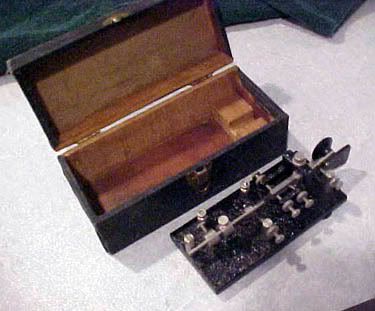It's been a few days since my last post, so I thought I might jot down a few lines while I have the chance.
I enjoyed the BARS club hamfest at Lawrenceburg a lot, though I didn't do a great deal of flea market shopping. There were some good bargains out there, so I probably should have taken time to do a little scrounging.
One local ham was looking for a new mic for his Icom IC-2200 VHF rig, and he found a rig and mic for $25 or $30. He didn't care if the rig worked, but it turned out it worked fine. The only catch — he still needs a mic for his micless new rig.
I bought a new NMO dualband 2/440 antenna for my SUV. I have a Yaesu FT-7800 to replace my FT-2800 2-meter rig. I'm not expecting to do a lot of 440 work, but the FT-7800 has some excellent expanded receive capability and plenty of memories. It will even allow you to bank memories just like a scanner.
A ham I know in Versailles picked up a nice key for song. It was a Autronic single lever key. I don't know why I like these keys so much, I assume its the styling. For a single lever key they work quite well, too. If I had my choice between the Autronic and a Vibroplex Vibrokeyer, the Autronic would win hands down.
—

SPEAKING OF KEYS. I've slowed down on eBay purchases lately (again), but I couldn't pass up an excellent key that showed up online recently — a very early Speed-X key (shown at right).
Before Les Logan bought Speed-X in 1937, the company was first owned by Stewart Johnson and was located in San Fransisco. The early Johnson-manufactured Speed-X keys were not equipped with ID plates. They were available in several widths — 2-1/2 inches, 3 inches and 3-1/2 inches. The narrowest one is similar to the Blue Racer.
These early Speed-X keys are often misidentified as a Vibroplex model. They're very similar, though the thumb paddle is a dead giveaway its Speed-X and not Vibroplex. The damper is also typical Speed-X design.
This model is the precursor to the later Les Logan Model 515. The photos don't do the key justice because it has a very shiny black wrinkle finish. The paint is absolutely perfect on it. In fact, the metal parts are all like new too. What's unique about this key is the metal parts are nickel plated rather than chrome. Later keys have chrome plating.
The base is not cast like a similar vintage Vibroplex. Instead its simply cut steel, thinner and somewhat lighter.
The key was sold with a wooden carrying case — not a Vibroplex style case, but one that probably was modified for this purpose by the key's original owner. The box is well constructed of wood. Inside the owner installed a filler so the key was held snuggly in place when placed down inside the box. The spacer was notched to accomodate the paddle. When the box is closed, the key is protected from moving around, much like a Vibroplex carrying case. They keying lever is well protected, the notched spacer is sized just right to prevent the keying lever from hitting the end of the box.

The box is just long enough to accomodate the key. I could believe the box was a Speed-X specific piece, but this isn't the case. The box does not have a carrying handle, which suggests it was a homebrew solution for the early owner.
In the bottom of the box, the original owner had a couple of magazine clippings of Morse code charts. One chart is for American Morse, the other is for International Morse. American Morse is also known as the “railroad code,” and was used on U.S. telegraphy circuits.
This key was probably sold as a “radio key” because it lacks a circuit closer switch.
These early Speed-X keys has very distinctive thumb pieces. I assume the theory was that by having much of the paddle positioned below the keying lever, it would make the key easier to use by not requiring you to hold your wrist or thumb higher to touch the paddle. The paddle does change how you handle the key compared to a similar model Vibroplex. Its not better or worse, just different. Speed-X changed the design on later paddles, though one thing they did differently than Vibroplex — Speed-X paddles on their bugs are adjustable.
How does this new Speed-X bug operate? All the adjustments were out of kilter on it, but it only took a few minutes to get everything in place. The contacts were clean and it operated just like it did 70 years ago. The key isn't as fast as I th ought it might be. Maybe its just its design or the age, but the key adjusts well below 20 wpm. Faster speeds are not a problem, either, though you'll have to remove a weight and adjust the remaining one to get up well near 30 wpm.
This key wasn't the bargain some of mine were, but that's ok. I'm surprised the price wasn't higher, actually. The key was not labled as a Speed-X key, and unless you looked over the listing carefully you could miss the key's true heritage. The photos don't do the black wrinkle finish justice.
Enough about keys. I probably should be using the thing instead of writing about it. 73.
